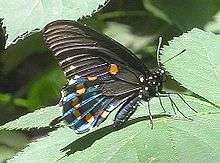Battus philenor hirsuta
| Battus philenor hirsuta | |
|---|---|
 | |
| Scientific classification | |
| Kingdom: | Animalia |
| Phylum: | Arthropoda |
| Class: | Insecta |
| Order: | Lepidoptera |
| Family: | Papilionidae |
| Tribe: | Troidini |
| Genus: | Battus |
| Species: | B. philenor |
| Subspecies: | B. p. hirsuta |
| Trinomial name | |
| Battus philenor hirsuta Skinner, 1908[1] | |
Battus philenor hirsuta, the California pipevine swallowtail or hairy pipevine swallowtail, is a subspecies of the pipevine swallowtail that is endemic to Northern California in the United States. Populations are found throughout the Sacramento Valley and outside of the valley in Contra Costa and Alameda counties. The butterfly is black with hindwings that have iridescent green-blue coloring above and a row of red spots below; the caterpillars are black with fleshy protrusions and red spots. The subspecies' butterflies are smaller in size and hairier than the species, and they lay eggs in larger clutch sizes than the species.[2][3] The egg clutches are deposited on the shoot tips of the California pipevine, a perennial vine native to riparian, chaparral, and woodland ecosystems of the California Coast Ranges, Sacramento Valley, and Sierra Nevada foothills. The larvae feed exclusively on the foliage and shoot tips of the pipevine, although adults eat floral nectar from a variety of plants.[2][4][5][6] The plant contains a toxic substance, aristolochic acid. The larvae sequester the toxin, and both the juvenile and adult butterflies have high and toxic concentrations of the aristolochic acid in their tissues. Throughout the range of the species, Battus philenor, other butterflies and moths mimic the distinctive coloration of the swallowtail to avoid predators. However, there are no known mimics of the Californian subspecies.[7]
References
- ↑ "ITIS Battus philenor hirsuta". Retrieved 30 August 2013.
- 1 2 Richard E. Warner, Kathleen M. Hendrix, ed. (1984). California Riparian Systems: Ecology, Conservation, and Productive Management. p. 937. ISBN 0520050355.
- ↑ Brock, Jim P.; Kaufman, Kenn (2003). Butterflies of North America. New York City, NY:: Houghton Mifflin Company. p. 26. ISBN 0-618-15312-8.
- ↑ Von Tilden, J W (1966). Butterflies of the San Francisco Bay Region. University of California Press. p. 54. ISBN 0520012682.
- ↑ "Jepson Flora Project: Aristolochia californica". Regents of the University of California. Retrieved 30 August 2013.
- ↑ Fordyce, James A.; Anurag A. Agrawal (2001). "The role of plant trichomes and caterpillar group size on growth and defence of the pipevine swallowtail Battus philenor". Journal of Animal Ecology. Blackwell Science Ltd. 70: 997–1005. doi:10.1046/j.0021-8790.2001.00568.x.
- ↑ Fordyce, James A. (2000). "A model without mimic: Aristolochic acids from the California pipevine swallowtail, Battus philenor hirsuta, and its host plant, Aristolochia californica". Journal of Chemical Ecology. 26 (11): 2567–2578. doi:10.1023/a:1005588829864.